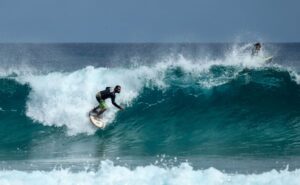The Importance of Mastering Turns in Surfing
At Pacific Surf School, instructors emphasize that mastering turning techniques is pivotal for any surfer looking to elevate their performance on the waves. Two fundamental turns – the bottom turn and the top turn – are essential for creating smooth, stylish, and powerful maneuvers. Understanding and practicing these turns can dramatically enhance your ability to navigate waves effectively. These foundational turns not only help you maintain speed and control but also set you up for more advanced maneuvers. Learning how to properly execute bottom and top turns is key to becoming a well-rounded and skilled surfer.
Understanding the Bottom Turn
The bottom turn is the first and most crucial turn that sets the stage for subsequent maneuvers. Pacific Surf School instructors explain that the bottom turn begins as you descend the wave face after takeoff. As you reach the bottom of the wave, shift your weight onto your back foot, applying pressure to the inside rail of your board. This action initiates the turn. Simultaneously, rotate your shoulders and hips in the direction you want to go, keeping your eyes focused on your target. A well-executed bottom turn generates speed and positions you for an effective top turn or other maneuvers.
Key Steps for Perfecting the Bottom Turn
Pacific Surf School instructors break down the bottom turn into simple, actionable steps. First, keep a low stance with knees bent to maintain balance and absorb the wave’s energy. As you approach the bottom of the wave, lean into the turn by pressing down on your back foot and engaging your inside rail. Use your arms to help guide the turn by pointing your leading arm in the direction you want to go. Keep your head up and eyes fixed on your target to maintain balance and control. Practicing these steps consistently will build muscle memory, making your bottom turns more fluid and powerful over time.
Executing the Top Turn with Precision
Once you’ve completed the bottom turn, the top turn comes next. The top turn allows you to redirect your board back down the wave’s face, maintaining speed and control. Pacific Surf School instructors advise beginning the top turn by shifting your weight from your back foot to your front foot as you approach the wave’s lip. Rotate your shoulders and hips to initiate the turn, and use your back foot to pivot the board while keeping your front foot light. A successful top turn should feel smooth and controlled, setting you up for further maneuvers.
Tips for a Powerful and Stylish Top Turn
Perfecting the top turn requires a combination of technique and timing. Pacific Surf School recommends practicing on waves of varying sizes to develop versatility. As you approach the wave’s lip, keep your body compact and your knees bent. Extend your leading arm to guide the board’s direction and maintain balance. Use your back foot to apply pressure and pivot the board effectively. Timing is crucial; initiate the top turn just before you reach the wave’s peak to maximize your speed and control. With regular practice, you’ll develop the ability to perform powerful and stylish top turns effortlessly.
Combining Bottom and Top Turns for Fluid Surfing
The seamless combination of bottom and top turns creates a fluid and dynamic surfing style. Pacific Surf School instructors teach surfers how to link these turns smoothly to maintain speed and flow through the wave. After executing a powerful bottom turn, use the momentum to carry you into a precise top turn. The goal is to keep your movements continuous and connected, creating a rhythm that allows you to make the most of each wave. Practicing this combination will enhance your ability to read and respond to the wave’s shape, leading to more enjoyable and effective rides.
Strengthening Your Core for Better Turns
Core strength plays a significant role in executing smooth and powerful turns. Pacific Surf School emphasizes the importance of core exercises such as planks, Russian twists, and leg raises in your fitness routine. A strong core provides stability and control, making it easier to initiate and complete turns. Incorporating these exercises into your training will improve your overall surfing performance, enhancing your ability to perform bottom and top turns with precision and power.
Receiving Real-Time Feedback from Experienced Instructors
One of the advantages of learning at Pacific Surf School is the opportunity to receive real-time feedback from seasoned instructors. They can observe your technique and provide immediate tips and adjustments to improve your turning skills. Whether it’s refining your body positioning or timing, this personalized feedback ensures quicker progress and the adoption of proper techniques. Practicing under the guidance of experts gives you the confidence and skills needed to master both bottom and top turns.
Conclusion: Mastering Turns with Pacific Surf School
Mastering the bottom turn and top turn is essential for any surfer looking to improve their performance and style on the waves. Pacific Surf School offers comprehensive instruction and personalized feedback to help surfers perfect these crucial maneuvers. By focusing on key techniques, body positioning, and core strength, you can achieve smoother, more powerful turns. Whether you’re a beginner eager to learn the basics or an experienced surfer looking to refine your technique, Pacific Surf School is dedicated to helping you master turning techniques and elevate your surfing experience.







